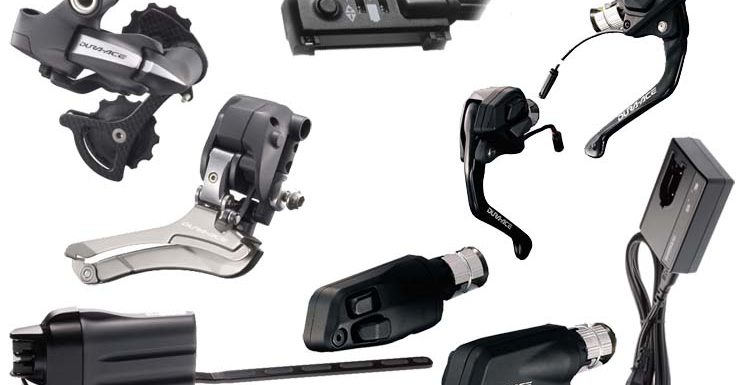
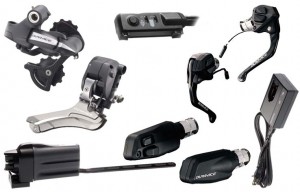 I learned quite a bit about Shimano Di2 when I installed one of the first available Time Trial/Triathlon groupsets on my Cervelo P2. I’ve subsequently answered a lot of questions on forums and article comments, and elsewhere. In doing so, I realized that people have a lot of questions about Di2 and the answers are difficult to find. This lead me to create this article, to consolidate everything I know and have been asked into one location so people can find answers. If you can’t find what you’re looking for below, please leave a comment and I’ll do my best to help.
I learned quite a bit about Shimano Di2 when I installed one of the first available Time Trial/Triathlon groupsets on my Cervelo P2. I’ve subsequently answered a lot of questions on forums and article comments, and elsewhere. In doing so, I realized that people have a lot of questions about Di2 and the answers are difficult to find. This lead me to create this article, to consolidate everything I know and have been asked into one location so people can find answers. If you can’t find what you’re looking for below, please leave a comment and I’ll do my best to help.
Index: There’s lots of info in this post, so here’s an Index to help you find specific sections:
- Di2 General Overview
- Compatibility: Between 6770 10-speed, 6780 11-speed, 9070 11-speed, first-gen 7970
- How to Check Battery Level
- How to Adjust Rear Derailleur Trim
- How to Adjust Front Derailleur Trim
- Dealer Installation Manuals
- Shimano E-tube Project Software – Change Settings and Update Firmware
- Chargers, PC USB Interfaces/Programmers
- Component Overviews
- Shift/Brake Levers
- Dedicated Shift Buttons
- Front Derailleurs
- Rear Derailleurs
- Display Units and ANT Bluetooth Wireless Communication Modules
- Batteries and Battery Mounts (Internal and External)
- Front Cable Connection A Junctions (with charger ports and LED status lights)
- Rear Cable Connect B Junctions
- Cables, Grommets, Cable Install Tools
- List of Components Needed to Build Your Own Di2 System
- Technical Details of the Di2 CANBUS protocol and signaling
System Overview: Shimano Di2 Dura-Ace 9150 and 9070 and Ultegra 6770 and 6870
The second generation Shimano Ultegra 6770/6870 and Dura-Ace 9070 “E-Tube” electronic bicycle shifting systems consist of battery-powered electric derailleurs activated by handlebar mounted push buttons. Power and shift commands are sent via a 2-wire CAN (Controller Area Network) datalink contained within a single cable housing. This design has several advantages over conventional mechanical shifting systems, the most notable of which are:
- Extremely low shifting effort, which generally results in more frequent shifts and therefore better gear ratio selection.
- Greatly improved shift quality, especially for the front derailleur chainrings, allowing shifting under full power with almost no chance of a dropped chain.
- Shifting is available at multiple positions on the handlebars, for example, at the end of the time trial aero bars, on the brake levers, up to in climbing position, and down low the sprint position.
- Automatic trimming of the front derailleur position as the rear derailleur moves back and forth between the smaller and bigger gears. This eliminates unintended contact (and noise) between the front derailleur and the chain.
- Lighter weight vs. equivalent mechanical system. The Shimano Dura-Ace Di2 9070 electronic groupset with internal battery weighs 2047 grams; the Shimano Dura-Ace 9000 mechanical groupset weighs 2074 grams (27 grams more than Di2.)
- Multi-Shift: Pressing and holding a rear derailleur shift button results in shifts through multiple gears. The rate of shifts can be configured using the PC computer interface cable and the free Shimano E-tube Project software.
- Synchronized Shifting: Starting with Dura-Ace 9150, automated Synchronized Sifting of the front derailleur is an option. Two SHIMANO Synchronized Shift modes will be available:
- Full SHIMANO Synchronized Shift: the front derailleur reacts based on the rear derailleur’s shift action. This essentially means that, when activated, there is no need for two separate shifters to control front and rear derailleurs, the two buttons on one shifter will control both derailleurs.
- Semi SHIMANO Synchronized Shift mode: the rear derailleur reacts based on the front derailleur’s shift action, shifting to the next most appropriate rear gear when the rider makes a front shift.
- R9120, R9170 – syncroshift enabled with firmware 3.2.0 or newer
- 6870, 9070 – syncroshift enabled with firmware 3.2.1 or newer
- 6770 – no syncroshift firmware update will be offered
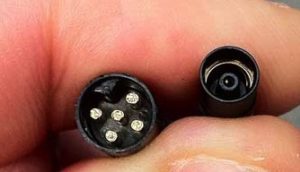 Historic Info on the older first generation 5-wire Shimano Dura-Ace Di2 DA-7970 system and how it compares to the new E-tube 2-wire system:
Historic Info on the older first generation 5-wire Shimano Dura-Ace Di2 DA-7970 system and how it compares to the new E-tube 2-wire system:
Released in 2009, the 7970 operated using a very basic 5-wire electronic system. Each shift button was connected to a different wire; shorting the specific wires together controlled the derailleur upshifts and downshifts. Because the first generation 7970 used completely different technologies than the newer 2-wire systems, none of the components are cross-compatible. At this point, Shimano is not expected to offer any updates or new components using the first generation 7970 architecture; everything from now on will be based on the newer 2-wire E-tube design. The second generation design offers several advantages, which include: 1) smaller wire size, smaller connector size, waterproof connectors; 2) all switches can be reconfigured in software to send upshift or downshift commands to either the front or rear derailleur; 3) firmware updates can add new features (such as multi-shift) and compatibility with new components.
Compatibility: Dura-Ace 9070 and Ultegra 6770 / 6870 (and old 5-conducter 7970)
The confusing naming system used by Shimano makes it difficult to figure out what each component is, much less what is compatible between systems. Here are some compatibility guidelines:
- Nothing from the first generation (4-conductor / 5-conductor) Dura-Ace Di2 7970 system is compatible with any other newer system. It was replaced by the (2-conductor) E-tube systems. No parts are inter-operable between 7970 and any other Di2 System.
- In general, every electronic Di2 component is compatible between the Ultegra 6770, 6870, and Dura-Ace 9070 systems (see exceptions below.) This means that all of the road bike Ultegra/Dura-Ace dual control brake levers/shifts, time trial shifters, and climbing shifters can be used with either Ultegra 6770/6870 or Dura-Ace 9070 front and rear derailleurs. Any of the Ultegra/Dura-Ace controllers (A Junctions) can be used with either system. All components use the same cables and connectors.
- Firmware Update Required to Make Older Components Compatible with Newer Components: If you add a new component and it doesn’t work, update the firmware using the PC USB adapter and the Shimano E-tube Project Software for Windows.
- Synchronized Shifting and Bluetooth Wireless Units can be added to all E-tube Ultegra and Dura-Ace systems but the battery has to be upgraded to the BT-DN110 Internal Battery or BM-DN100 External Battery Mount. To add Bluetooth capability, a EW-WU101 or EW-WU111 inline transmitter must be added to road bikes and for mountain bikes, the SC-MT800 or SC-M9051 display/transmitter unit must be added.
- Compatibility Exceptions:
- Note 1 – Sprint Shifter Exception: The Sprint Shifter is the only exception for shifter incompatibility. It has a different wiring connector (and internal components) that can only plug into a unique/dedicated third port on the Dura-Ace ST-9070 Dual Control Brake Levers/Shifters and also the ST-6870 Levers. There is no sprint shifter port on the ST-R785 Hydraulic Levers.
- Note 2 – Can’t mix 10-speed/11-speed front/rear Derailleurs: It is no longer possible to use a 10-speed front derailleur with an 11-speed rear derailleur (and 11-speed front with 10-speed rear.) See note farther below to read the history on this if you want all the messy details.
- Note 3 – Front A junction and Internal Battery: Since the February 2015 firmware update, the older SM-EW67-A-E Front Junction A is no longer compatible with the BTR2 Internal Battery because it does not have the charging port to charge the internal battery. The SM-EW90 Front Junction (with integrated charging port) should be used instead. The SM-EW67 still works with the external battery.
- Note 4 – Update the Firmware to make components compatible: If the firmware on all components is not updated to the latest version, some components may be not operate correctly with one another. So download the latest E-tube software and update everything and it should work.
- Note 5 – All Shifters work with all 10-speed and/or 11-speed Rear Derailleurs: All of the shifters are compatible with either the 10-speed Ultegra 6770 or 11-speed Ultegra 6870/Dura-Ace 9070 systems as long as they all have the latest firmware. The rear derailleur is the only component that “knows” or “cares” how many rear gears are available. The shifters only send upshift/downshift commands and do not “know” or “care” which gear is currently selected and how many total gears there are.
- Note 6 – SM-BTR1 External Battery and SM-BMR1 Mount firmware updates: The more expensive dedicate service tool (SM-PCE1 PC Interface) must be used to upgrade the firmware on the external battery/mount.The external battery and battery mount can not receive firmware upgrades via the SM-EW90 Front Junction A and the SM-BCR2 PC Interface/Battery Charger. (The SM-EW90 will work in a system with an external battery, but a firmware update can cause them to become incompatible until both are updated independently using the appropriate PC Interface and the Shimano E-Tube Project software.)
- See the Shimano E-tube compatibility chart version 3.4.3 for more details
Compatibility: 11-Speed Rear Derailleur and 10-speed sprockets/wheels
The 11-speed Dura-Ace 9070 and Ultegra 6870 rear derailleurs are designed exclusively for 11-speed rear sprockets and 11-speed Front Derailleurs. Shimano does not provide a way to recalibrate/reprogram them for a 10-speed setup. The sprocket spacing is slightly smaller and the overall range of travel slightly longer on 11-speed systems. If you have 10-speed wheels and 10-speed sprockets, you should use the 10-speed RD-6770 rear derailleur and a 10-speed FD-6770 front derailleur.
Similarly, a 10-speed RD-6770 rear derailleur should not be used with 11-speed sprockets. There will be chatter in some gears, and there might be slow-shifts or self-shifts.
It doesn’t matter which shifters are used; the shifters send upshift/downshift commands regardless of which derailleur config is being used. Shifters do not “know” or “care” which gear is currently selected and how many total gears there are.
Front Chain Rings: In general, most any front chain rings will work, rigid forged rings work best with Di2 due to high front derailleur shift forces. Shimano chain rings tend to be the best, but most others work as well. A 10-speed specific or 11-speed specific chain should be used, but the differences between them are minimal and can generally be mixed/matched without issue.
How to convert “non-upgradeable 10-speed only” wheels such as Zipp 900/Sub9 Disc Wheels to 11-speed: “the spacing between a Campy 11 and Shimano 11 is close enough that you can use the cassettes interchangeably. If you get a Campy free hub body, the 2 shims (part# is on the Zipp website, just search for Campagnolo 11) and a Campy cassette and you’re ready to ride with all 11 cogs available to use.” via slowtwitch.com
But it’s an emergency and I need to use a 10-speed wheel. . . In emergency situations, 11-speed rear derailleurs can be used with 10-speed sprockets. There will probably be chatter in some gears, and there might be slow-shifts or self-shifts. To setup an 11-speed rear derailleur for a 10-speed sprocket setup, adjust the mechanical limit screw so that it can’t shift into the missing 11th sprocket position, then follow the rear derailleur adjustment procedures listed below.
Included for very motivated individuals only: 10-speed front derailleurs can be used with 11-speed rear derailleurs if the shifters and battery have firmware installed from E-tube software version 2.5.2 or earlier. Shimano disabled support for this 11-speed and 10-speed cross-matching with later firmware updates. For informational purposes only, the details of how to regain compatibility are detailed below.
- Important Notice 2014-07-14: There is a compatibility issue with Shimano e-Tube software/firmware versions v2.6.0 and later that prevents 10-speed front derailleurs (FD-6770) from working with 11-speed rear derailleurs (RD-6870) and 11-speed front derailleurs (FD-6870) from working with 10-speed rear derailleurs (RD-6770). DO NOT UPDATE FIRMWARE using Shimano e-Tube software v2.6.0 or later if you are mixing an FD-6770 front derailleur and a RD-6870 11-speed rear derailleur, or a FD-6870 with a RD-6770.
- The problem component is the battery (external battery mounts SM-BMR1 and SM-BMR2, internal seat post battery SM-BTR2.) If you keep battery firmware at v2.0.6 or earlier, the system will continue to function properly. Shimano e-Tube Software v2.6.0 will update battery firmware to v3.0.5, and will not allow the RD-6870 to work with a FD-6770 setup.
- If the battery firmware is updated to 3.0.5, it CAN NOT be rewritten back to the older version. You will need to need to replace a derailleur so that both are 6770 10-speed or so that that both are 6870 11-speed. (The other option is to get get a battery with the older firmware and never update it.)
- Here’s a link to the “last known good version” of the Shimano e-Tube software to work with a mixed 10-speed/11-speed system: E-tube_Proj_V_2_5_2.zip Use this version and do not connect to the internet when using it so that E-tube can’t check for updates when open.
- To roll-back newer versions of battery and shifter firmware, install E-tube version 2.5.2 and made a copy of “C:\ProgramData\E-tube Project\FW” which has all the firmwares packaged in that version of E-tube. Next, install the latest version of E-tube. Then copy all the firmwares from the the 2.2.3 version back to the same location “C:\ProgramData\E-tube Project\FW” for the latest version (note: ProgramData is a hidden directory, click here for details on how to view it.). Next, the trick is to find the firmware you want to downgrade (pretty easy from the name and version in the file name), and then rename it to the same name as the latest version, but increment the last version digit by one. Then connect to the bike with E-tube (without an internet connection) and it will identify that a firmware upgrade is available for that component and allow you to do the firmware “upgrade” to the older version of firmware. Now exit E-tube and then rename the firmware file back to original to prevent the issue in future. E-tube will then try to upgrade again but just don’t let it do that. This should get a bike that did nothing (not even enter adjustment mode) to a fully working state by reverting the battery and shifters. Running latest firmware in derailleurs seems to be fine. (thanks to commenter vosadrain)
- It will not be possible to charge the BTR2 internal battery using the BCR2 USB charger unless you also downgrade the firmware of the BCR2 USB charger as well.
- Note however that latest E-tube software will say the setup is unsupported and will not allow programming. To do programming, disconnect the internal battery and connect a spare external battery. This allows making settings changes. To program the BTR2 itself, I just connect to the BTR2 by itself (no other components) and the E-tube software will allow firmware changes to it. Or try using the 2.5.2 version of E-tube.
- Alternatively, buy a Di2DIY internal seat post battery kit and you will not have to go through the firmware downgrading. The kit makes it possible to run all components with the latest E-tube firmware. Also worth noting some firmware updates were done to fix power distribution errors in the FPGA’s that would allow the batteries to drain down when the bike was just sitting.
Checking Battery Charge Level:
A single battery charge should give at least 1500 miles of riding. Most riders will not need to charge the battery more than twice a year.
To check the battery charge remaining, press and hold any shifting switch for 0.5 seconds or more. The amount of battery charge remaining will be indicated by the light on Front Controller A Junction.
- 100% remaining: Illuminates green (for 2 seconds)
- 50% remaining: Flashes green (5 times)
- 25% remaining: Illuminates red (for 2 seconds)
- 0% remaining: Flashes red (5 times)
When the battery charge is low, first the front derailleur will stop operating, and then the rear derailleur will stop operating. When the battery charge has been fully spent, the derailleurs will be fixed at the last gear shifting position. If the battery indicator is illuminated red, it is recommended that you recharge the battery as soon as possible.
Adjusting the Rear Derailleur Trim:
If you switch between multiple rear wheels, it’s very likely that the sprockets on different wheels won’t be in exactly the same relative position to the rear derailleur, resulting in that annoying clicking sound as the chain makes contact with an adjacent sprocket. Follow the steps below to properly align the rear derailleur with the rear sprockets.
- Shift the rear derailleur to the 5th sprocket position. Press the button at the junction (A) of the SM-EW67-A-E until the red LED illuminates in order to switch to rear derailleur adjustment mode. Note that if you keep pressing the button after the red LED has illuminated, protection recovery operation will begin.
- If shifting switch is pressed once while the initial setting condition is active, the guide pulley will move one step toward the inside. If shifting switch (Y) is pressed once, the guide pulley will move one step toward the outside.
- Note: The guide pulley can move 15 steps inward and 15 steps outward from the initial position, for a total of 31 positions.
- Note: When adjusting, the guide pulley will overrun slightly and then move back in an exaggerated movement so that you can check the adjustment direction. When checking the positions of the guide pulley and the sprocket, check at the position where the guide pulley finally stops.
- While turning the front chainwheel, operate shifting switch to move the guide pulley toward the inside until the chain touches the 4th sprocket and makes a slight noise.
- Next, operate shifting switch 4 times to move the guide pulley toward the outside by 4 steps to the target position.
- Press the button at junction (A) until the red LED turns off in order to switch from rear derailleur adjustment mode to gear shifting mode. Shift to each gear and check that no noise is generated at any gear position. If fine adjustment is needed, switch back to adjustment mode and readjust the rear derailleur.
- Note: if you have customized your shifters and swapped buttons, this will change which shifter and buttons control the micro-adjustments. Also, if you hit the wrong buttons while trying to set the FD trim, you can actually alter the setup of your RD. Be certain that you’re hitting the correct adjustment buttons.
- If you have a Garmin or similar head unit and a SM-EWW01 ANT module, the display will automatically switch into derailleur trim display when you activate that mode (i.e. by pressing the button at the junction (A) of the SM-EW67-A-E.) It will give you the trim position in either + or – 12 positions. When switching wheels, simply take note which position suits which wheel/sprocket/trainer, and trim to that level each time you change. This removes the guesswork and makes changing from wheel to trainer simple.
Note on FD-6870 Front Derailleur Trim:
The FD-6870 trim adjustment effects the auto-trim positions. The adjustment feature is accessible via either the A-Junction box, or the “Front derailleur adjustment setting” in the e-tube software, and should be used only after you have already set the physical inner/outer limit screws. So for example, if the FD outer plate rubs the chain when using the 6th largest cog, you would want to adjust the FD trim outward a couple ticks. However, you can only perform this adjustment while in the big-ring/big-cog combination. Etube forces the derailleurs into this maximum cross-chained position, whereas during the manual method you must shift to these positions yourself. (Thanks to commenter Bryan B for the info.)
Dealer Manuals:
The dealer’s manuals contain the most detailed information available from Shimano. If you’re looking for detailed installation instructions, check here:
- Shimano Ultegra 6770 Dealer’s Manual: http://techdocs.shimano.com/media/techdocs/content/cycle/SI/Ultegra/UltegraDi2/6770Di2_DM_EN_v1_m56577569830773882.pdf
- Shimano Ultegra 6870 Dealer’s Manual: http://si.shimano.com/php/download.php?file=pdf/dm/DM-UL0001-00-ENG.pdf
- Shimano Dura-Ace 9070 Dealer’s Manual: http://si.shimano.com/pdf/dm/DM-DA0001-00-ENG.pdf
- Shimano Alfine Di2: http://si.shimano.com/php/download.php?file=pdf/dm/DM-AL0001-03-ENG.pdf
Shimano E-tube Project Configuration and Firmware Update Software for Windows:
Shimano E-tube Project Wireless for iOS and Android: Announced on April 15, 2016 but as of yet unreleased, these apps will allow configuration of shift profiles (multi-shift on/off, multi-shift delay between shifts, shifter button assignments) and firmware updates over Bluetooth. To function, a Shimano Di2 Bluetooth Adapter, such as the MT800 digital display, is required.
Shimano E-tube Project Windows PC Software: This free software is used to update the firmware of all components. It works with the SM-BCR2 Charger + USB Adapter and the SM-PCE1 Diagnostic Adapter. The software is used to change the configuration of each shift button / lever (any can be programmed to upshift or downshift either the front or the rear derailleur.) It can also be used to enable multi-shift (multi-shift is where the shifter is held and the rear derailleur shifts through multiple gears until the shifter is released.) The delay between of the gear changes during multi-shifting can also be adjusted. The software is available from http://e-tubeproject.shimano.com/
Older versions of the e-tube software are available from these links: 2.5.2
PC & Mobile Interfaces, Chargers, and Software:
SM-BCR1 Battery Charger: This is used to charge the external battery. The part number for the battery charger wall cord is SM-BCC1.
SM-BCR2 Charging and PC Connection: for SM-EW90-A 3-port and SM-EW90-B 5-port A Junctions. This plugs into a special port on the side of the A junctions (which is covered by a rubber flap.) This adapter charges the internal battery when first plugged into the A junction; it must be powered by a standard USB Wall charger (such as that used for an Apple iPhone) or a PC that is powered-on. If the Shimano E-Tube Project Software is launched on the Windows PC with the SM-BCR2 attached, the SM-BCR2 will switch from charging mode to configuration mode. It must be detached from the computer and reattached to switch back to charging mode.
- It takes about 2 hours to charge the internal battery.
- Amber light=charging.
- Light turns off when done.
- If the Amber light does not come on when plugged in, this indicates battery is not discharged enough to charge.
- Light flashing indicates something is wrong, like trying to charge a external battery through a BMR.
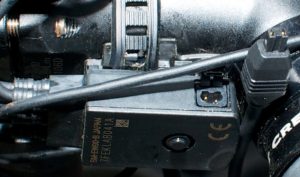
Hacking the SM-BCR2 to have a standard Di2 cable connector: If your 3-port or 5-port junction is inaccessible for charging, there is an alternative hack method to connect it to the system through a standard Di2 port. With basic soldering skills you can hack the BCR2 to be used with any setup. Buy any length EW-SD50 wire, cut off one end. Cut the wire on the output side of the BCR2. Splice the two wires together, so that the output wire of the BCR2 is now a standard Di2 connector. The charger has an inner (white) and outer (shield) wire; connect the inner white wire to the SD50 red wire; connect the charger outer shield wire to the SD50 black wire. You will then be able to plug the BCR2 into any Di2 port. Or use a SM-JC40 junction B and another length of EW-SD50 wire and go through the RD (by using the SM-JC40 to connect the rear derailleur, new output wire of the EW-SD50, and the wire that ordinarily connect the rest of the system to the rear derailleur.) Thanks to @Di2diy for the info.
SM-PCE1: This PC Configuration and Diagnostics adapter will not charge the internal battery. It offers the same configuration options as the SM-BCR2, but also add some advanced diagnostic and troubleshooting features that the SM-BCR2 does not have. It attaches to via the standard E-tube wire (just like the EW-SD50 cables) rather than to a dedicated port on the side of the front A junction.
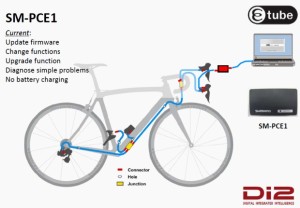
Bluetooth and E-tube Apps for Apple iOS and Android: Bluetooth wireless modules are available to allow system settings to be adjusted via the mobile applications that connect via Bluetooth Adapters.
Component Overview:
The confusing naming system used by Shimano makes it difficult to figure out what each component is, much less what it does and how it fits into an a complete Di2 system. Here’s an overview of all the major Ultegra and Dura-Ace Di2 components.
Dual Control Brake Levers/Shifters (a.k.a. Brifters):
ST-6770 Ultegra Road Dual Control Brake Levers/Shifters: The Ultegra version can be used with the climbing shifters. They are sold in in left/right pairs and are also available separately.
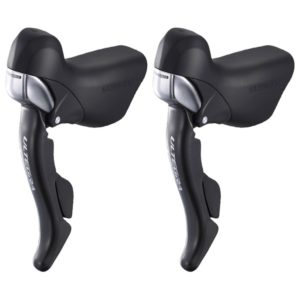
ST-9070 Dura-Ace Road Dual Control Brake Levers/Shifters: The main advantages these have over the ST-6770 version is slightly lighter weight and compatibility with the low-mount sprint shifters. As like the Ultegra version, they are compatible with the climbing shifters. They also have hidden button under the rubber hoods that can activate screen changes on cycling computers from Garmin, Magellan, Pioneer, and Shimano (Shimano SM-EWW01 ANT Wireless Broadcast Module required.)
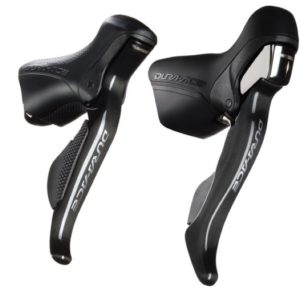
ST-9071 Dura-Ace Time Trial/Triathlon Dual Control Brake Levers/Shifters: These levers provide shifting from the pursuit bar position on time trial bikes. There is no Ultegra option offered at this time. These are available as left/right pairs, or can be ordered separately. These do have a permanently attached wire with a male end for connection the the SM-EW90 front “A” junction. Combined weight both levers: 117 grams.
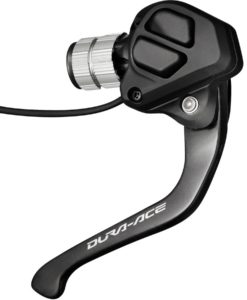
ST-R9160 (standard cable brakes) and ST-R9180 (hydraulic brakes) Time Trial Dual Control Brake Levels/Shifters: These are the lower-profile shifters offered with the newer Dura-Ace R9150 groupset.
ST-6871 Ultegra Time Trial/Triathlon Dual Control Brake Levers/Shifters: Ultegra version of the ST-9071 Dura-Ace shifters. Slightly heavier and much less expensive than the Dura-Ace version. Combined weight both levers: 142 grams.
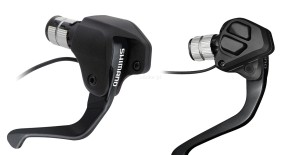
ST-R785 Hydraulic Road Dual Control Brake Levers/Shifters: These hydraulic road shifters are compatible with both the climbing and sprint shifters. These are compatible with the SM-RT99 centerlock 140mm and 160mm rotors and WH-RX31 wheelset (which as no standard rim brake track.) These require the BR-785 dual piston hydraulic disc calipers. They do not have the special wiring port required for the SW-R610 Sprint Shifters and a SM-EW90-B 5-port junction A is required to use the SW-R600 climbing shifter.
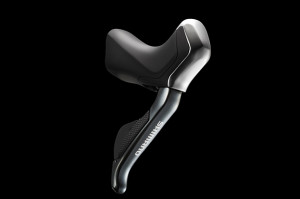
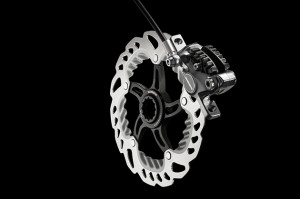
ST-6870 Ultegra Road Dual Control Brake Levers/Shifters: These road shifters are compatible with both the climbing and sprint shifters.
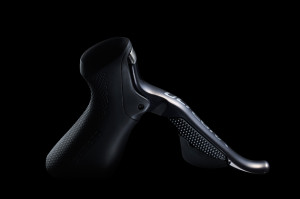
Dedicated Shifters:
SW-R671 Dura-Ace 2-Button Time Trial/Triathlon Bar End Shifters: These shifters are installed on the end of time trial aero bars. By default, the left shifter upshifts/downshifts the front derailleur; the right controls the rear derailleur. For both, the lower button upshifts into a harder gear and the upper button downshifts to an easier gear. This can be changed using the Shimano E-tube Project software; the functions of the left and right sifters can be switched with one another as well. These are available in pairs or separately.
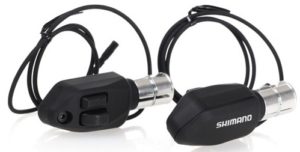
SW-9071 Dura-Ace 1-Button Time Trial/Triathlon Bar End Shifters: These shifters have only one button each and are intended to control only the rear derailleur, with one sending the upshift command and the other the downshift command. (I personally think this version is absolutely worthless. Why have 2 SW-9071 shifters at twice the price and twice the weight, when you can just buy a single SW-R671 Right shifter instead.)
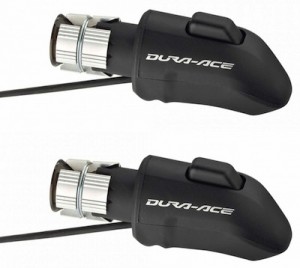
SW-R600 Climbing/PAVE Shifter: This shifter is for road bikes and is mounted on the upper horizontal portion of the handlebar, or any other location comfortable for the rider. They can be used in addition to the Dual Control Brake Lever/Shifter, or can be used on their own by plugging directly into a SM-EW90-A 3-Port Junction or SM-EW90-B Dura-Ace 5-Port Junction.
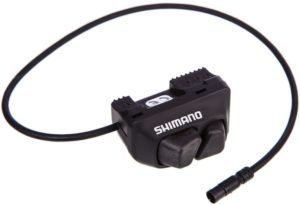
SW-R610 Dura-Ace Sprint Shifter: This is the only component using a unique wiring connector; it is only compatible with the ST-9070 Dura-Ace and Ultegra ST-6870 Road Dual Control Brake Levers/Shifters. Unlike all of the other shifters, the sprint shifters do not contain a circuit board; they do not show up as components on the CAN bus network. Instead, the sprint shifters are simple momentary switches that activate the circuit board on the host Dual Control Brake Lever/Shifter. The host dual control lever is what sends the shift command. (Note: Any momentary switch can be attached to the sprint shifter port on the Dual Control Levers by splicing into a standard EW-SD50 wire to act as remote shifters.)
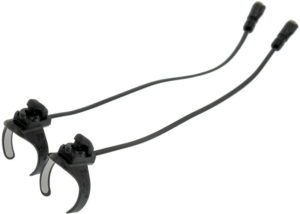
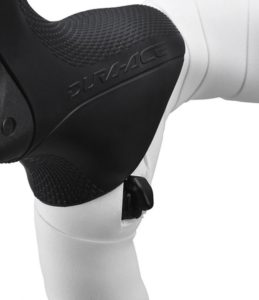
Alfine SW-S705 Right Flat-Bar Shifter: Reported to work with other non-Alfine setups.
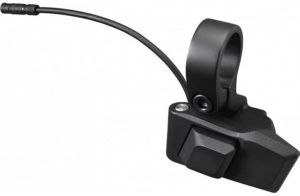
SW-R9160 Time Trial bar-end shifters (pair): These are-end shifters directly control the rear derailleur, with one for the upshfit and one for the downshift. The front derailleur is controlled automatically via automatic Synchronized Shifting. These shifters require the BT-DN110 Internal Battery for synchronized shifting.
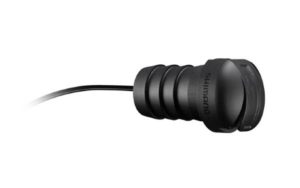
SW-R9150 Climbing shifters (pair): These tiny climbing shifters are about as small as the sprint shifters, but can be directly connected to a junction box and do not have to be connected as slave buttons to a brake/shift lever special port. They come with plastic mounts to make it easier to attach to bars beneath bar tape. They are ideal for synchronized shifting, with one controlling the upshifts and the other downshifts. These shifters require the BT-DN110 Internal Battery for synchronized shifting.
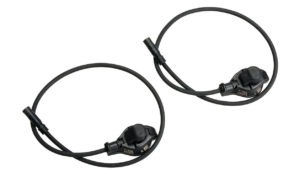

Front Derailleurs:
FD-6770: Ultegra Front Derailleur
FD-6870: Ultegra Front Derailleur, pretty much identical to the FD-6770 but with a slightly larger diameter adjusting screw (to better dissipate the shifting forces).
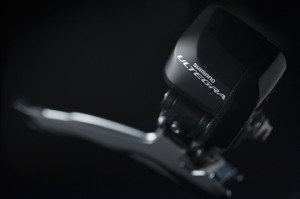
FD-9070: Dura-Ace Front Derailleur
FD-R9150: Dura-Ace Front Derailleur for 9150 systems; features slightly reduced weight vs. 9070.
Rear Derailleurs:
RD-6770: Ultegra 10-Speed Rear Derailleur, compatible with gears up to 28 teeth.
RD-6870: Ultegra 11-Speed Rear Derailleur, compatible with gears up to 32 teeth (for the GS version).
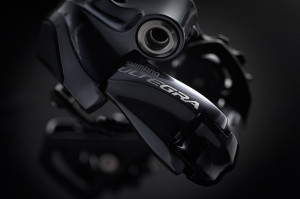
RD-9070: Dura-Ace 11-Speed Rear Derailleur, lighter weight version on which the RD-6870 is based.
RD-R9150: Dura-Ace 11-Speed Rear Derailleur with 30-tooth sprocket compatibility and modified “Shadow RD” geometry to keep the mechanism close to the rear wheel to help avoid damage in the event of an accident.
Alfine SG-S505 and SG-S705: The Shimano series targets comfort and urban bikes. It uses an 8-speed (505) or 11-speed (705) internal epicyclic rear hub. It is believed to be compatible with other Di2 ETube components but this has not been verified.
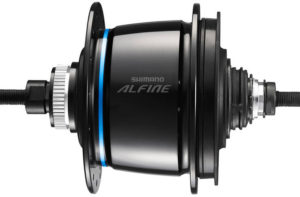
Display / Wireless Communication:
SM-EWW01 ANT Wireless Broadcast Module: This module wirelessly broadcasts Di2 data (front and rear gear selection details, gear ratio, battery life) to a cycling computer using the ANT protocol. It is compatible with Dura-Ace 9070, Ultegra 6870 Di2 and Ultegra 6770 E-tube road shifting systems. SM-EWW01 plugs into the E-tube wiring system between existing components. It has an 2 wiring ports, so it can be connected between a front shifter and the Front Junction A, or at the rear derailleur (between rear derailleur and Etube wire.) It transmits through a proprietary private ANT wireless protocol, which may eventually become a standard public ANT+ protocol. It is powered by the same Di2 system battery. It is currently compatible with the Garmin Edge 1000, Mio 505, and the PRO SCIO cycling computers (with more to come.) The hidden buttons under the hoods of the 9070 shifter levers will switch screens on the cycling computer when paired with this module. It does not currently allow for shifting control from a cycling computer/device and it is not clear that this functionality will ever be offered. The SM-EWW01 is 38mm long, 25mm wide, 12.5mm high, and weighs less than 5 grams. It does not come with any wires; 1 wire would have to be added if adding this module to an existing Di2 system.
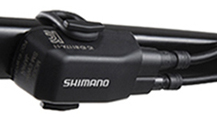
EW-WU101 and EW-WU111 ANT and Bluetooth Wireless Broadcast Modules: These modules are similar to the SM-WEE01 but also include Bluetooth capabilities in addition to ANT capabilities. They require the BT-DN110 battery or the BM-DN100 Battery Mount and cannot be used with the SM-EW67 Front A Junction.
SC705 Alfine Display Unit: This unit displays the battery level and the rear derailleur gear selection. It is powered by the system battery and has a port for the SM-BCR2 internal battery charger / USB diagnostic tool. It is primarily designed for Alfine systems (both 8 505-series and 11 speed 705-series). It is compatible with Ultegra and Dura-Ace Di2.
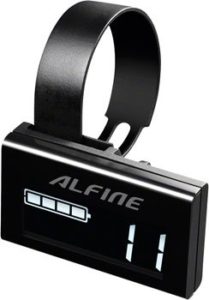
MT800 Digital Display with Bluetooth: Primarily aimed at XT mountain bike applications, this display allows toggling between the 3 synchronized shift modes (where both derailleurs are intelligently coordinated in unison by one pair of buttons, so no need for discrete shifting of the front derailleur.) It also shows battery level, gear position, shift mode and FOX iRD suspension position. The Digital Display required the new BT-DN110 battery. Existing Di2 XT systems are upgradable to be compatible with the new digital display after battery upgrade and firmware upgrade. This display has 3-port Di2 Cable junction and charging port integrated into the back and serves as a Front A Junction.
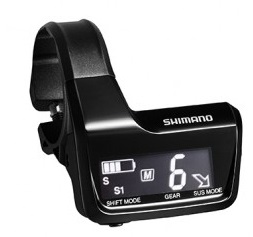
Batteries and Battery Mounts:
The batteries contain the main controllers for the system. It is therefore required to upgrade the battery to get features released in new versions of Di2 (such as Synchronized Shifting that automatically controls the front derailleur based on rear derailleur shifting.)
SM-BTR1 External Battery: This external battery must be used with the SM-BMR1 battery mount. It is removed from the mount and charged using a dedicated charger.
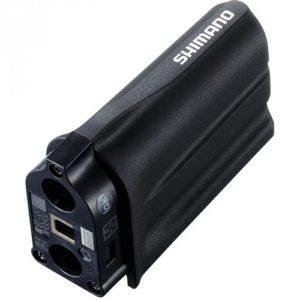
SM-BMR1 and SM-BMR2 External Battery Mount: This mount attached to bottle cage mount points or other dedicated frame mounts. It is available in 3 different mount lengths: -I (intermediate length), -S (short length), -L (long length). The SM-BMR2 is an updated version of the SM-BMR1.
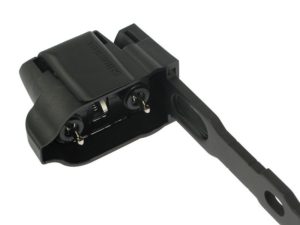
SM-BTR2 Internal Battery: This battery is typically mounted in the seat post or seat tube of the frame. It is charged by plugging the SM-BCR2 Charging Cable/PC Adapter into the SM-EW90-A or SM-EW90-B Front A junctions.
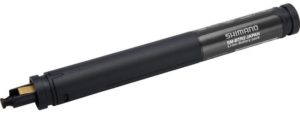
BT-DN110 Internal Battery: This battery is required for Bluetooth wireless units and road groupset Synchronized Shifting functionality.
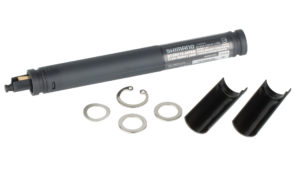
BM-DN100 External Battery Mount: This battery is required for Bluetooth wireless units and road groupset Synchronized Shifting functionality.
Front A Junctions:
SM-EW67-A-E Ultegra 3-Cable Junction: This is the original front junction with 2 integrated cables to connect to the dual control brake lever/shifters. The male cable ends on this Front A Junction will not mate directly to the male cable ends on any of the Time Trial/Triathlon dual control brake shift levers or shifters; SM-JC41 Rear B Junctions can be used to connect this front A junction to TT/Triathlon shifters. This Junction works only with External Batteries, not Internal Batteries.
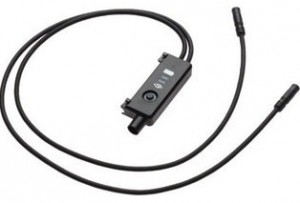
SM-EW90-A Dura-Ace 3-Port Junction: This front “A” junction is most commonly used in road bike setups. 2 ports connect to the dual control brake / shift levers; the third port is for the cable that leads to the bottom bracket junction.
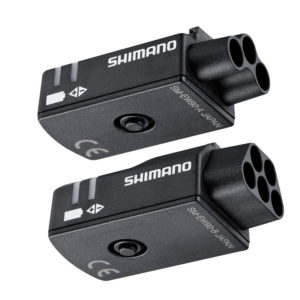

SM-EW90-B Dura-Ace 5-Port Junction: This front “A” junction is primarily used in the Time Trial / Triathlon setups. 2 of the port are for the brake/shifter dual control levers, 2 of the ports are for the aer0 bar bar-end shifters, and the 5th port is for the cable that runs to the bottom bracket (where the B junction joins the wires from the front A junction, front derailleur, rear derailleur, and battery.)
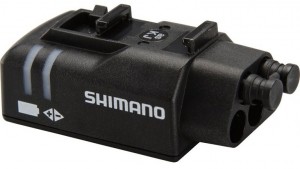
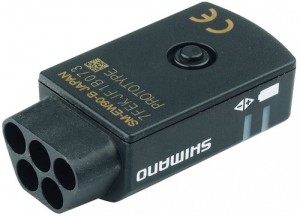
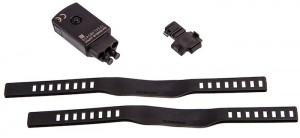
EW-RS910 Internal Bar-end Junction: This junction is installed into the end of a bar or in a dedicated frame port. It facilitates internal cable routing.
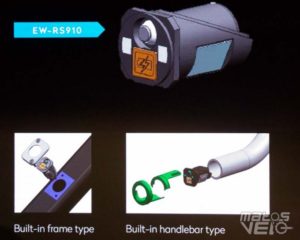
B Junctions:
SM-JC41 Internal Junction: This version has the exact functionality as the SM-JC40 external version, but doesn’t have the mounting tab for being bolted to the bottom bracket or wrapping the extra cable lengths. It has 2 ports on one end and 2 on the other, making it more compact. In addition to being located at the bottom bracket to connect the A junction, battery, front derailleur, and rear derailleur, it can be used at the handle bars to join multiple shifters prior to being connected to the A Junction.
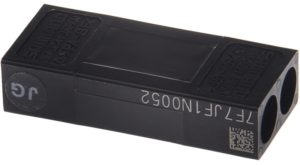
SM-JC40 External Junction: This version is intended to be attached to the frame using the bolt that is commonly located underneath the bottom bracket housing. This junction contains no electronics; it’s sole purpose is to join 4 connectors together, which are usually the wire from the front A junction, the battery, the front derailleur, and the rear derailleur. There are wire holders above the housing to capture the extra wire length by wrapping it back-and-forth.
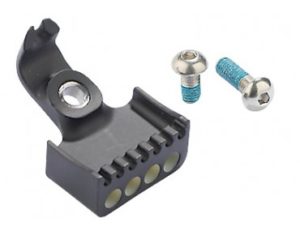
Cables, Grommets, and Cable Remove/Install Tool:
EW-SD50 Cables: These cables connect the front A junction, the battery, the front derailleur, and the rear derailleur to the rear B junction, which is typically located near the bottom bracket (near the cranks.) These are available in lengths of 300mm, 350mm, 400mm, 500mm, 550mm, 600mm, 700mm, 750mm, 950mm, 1000mm, 1200mm, 1400mm.
SM-GM01 Grommet: These round grommets are used when drilling round holes for internal cable routing, or with existing round holes. The required hole diameter is 6mm (6mm = .236 inches. Use a 7/32-inch drill bit and then “wallow-out” the hole to make it a little bigger; a 1/4-inch drill bit will work but is just slightly larger than necessary.)
SM-GM02 Grommet: These 7mm x 8mm oval shape grommets are used in some situations / frame designs.
Shimano TL-EW02 Ultegra DI2 E-Tube Tool: This tool is used to connect and disconnect the Etube wires. They are extremely difficult to connect/disconnect by hand, and pliers or other tools can damage the wires. Don’t get this confused with the TL-EW01 tool, which is for the older 5-wire 7970 cables. (My Dura-Ace TT Dual Control Levers came with one of these tools, but no other components did.)
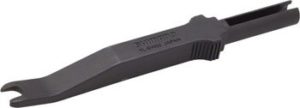
Common Questions (via Shimano):
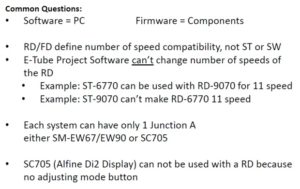
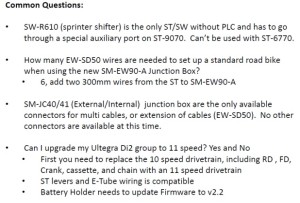
Note: it is not necessary to replace the FD from upgrading from 10-speed to 11-speed.
What Components do I need to put together my own Di2 system?
Because of the huge number and variety of components, it’s very difficult to figure out what is actually necessary and what is optional. So here is a list, for the setup I recommend: Ultegra 6870. It starts from the handlebars and works backwards. (This assumes both front and rear derailleurs, but you actually don’t have to have both; you can pick one or the other and only the corresponding front shifter to go along with it.)
- Any Type of Shifters / Shift Buttons. The Dual Control Brake Levers/Shifters are not required. You can get the just the climbing shifters or Triathlon/TT bar-end shifters, and then potentially add the Dual Control Levers/Shifters at a later point. (The only exception is the Sprint shifters, which require specific Dual Control Levers/Shifters with special ports as noted elsewhere in this article.) Amazon.com link
- EW-SD50 Wires 1 and 2 between the front shifters and the Front Junction A (0nly for some shifters). This is a bit confusing, because some of the front shifters come with wiring attached to them and some of them require purchasing separate wires. In general, most of the stand-alone shifters come with wiring, as do the TT/Triathlon dual control shifters/levers, but the road dual control levers do not. Amazon.com link
- Front Junction A. I recommend the SM-EW90-B 5-port front junction A as it provides the most upgrade flexibility; get the 3-port option only if you’re positive you’re never going to add more shifting components. The older SM-EW67-A-E has 2 wires built-in to connect with each of the dual control shift/brake levers; it doesn’t offer much flexibility or compatibility with a TT/Triathlon setup or adding additional shifters. Amazon.com link
- EW-SD50 Wire 3 between the Front Junction A and the 4-port Rear Junction B connector. Amazon.com link
- EW-SD50 Wire 4 between the Rear Junction B and the Front Derailleur. Amazon.com link
- EW-SD50 Wire 5 between the Rear Junction B and the Battery. Amazon.com link
- EW-SD50 Wire 6 between the Rear Junction B and the Rear Derailleur. Amazon.com link
- Rear Junction B: This is where the wire from the front of the bike is connected to 3 output wires leading to the front derailleur, rear derailleur, and battery. SM-JC40 is for external wiring, SM-JC41 is for internal. Amazon.com link
- Grommets for any place where the wire goes into the frame through a drilled hole. Amazon.com link
- Front Derailleur. I recommend the Ultegra FD-6870 for 11-speed builds or the FD-6770 for 10-speed builds. The Dura-Ace FD-9070 is pretty much identical, just slightly (41g) lighter and 11-speed only. (I do not recommend the Ultegra FD-6770 unless you have a 10-speed setup, because of firmware compatibility issues with 11-speed rear derailleurs. Also, it is an older design than the FD-6870, so it is larger and offers slightly less shifting force.) Amazon.com link
- Battery and Charger. Internal or external, depending on the build. If you have to skill/time/money-to-pay-someone to get everything internal, I highly recommend that option. The SM-BTR2 internal battery has more advanced integrated electronics and is better for firmware upgrades with the SM-BCR2 internal battery charger/PC tool. If you go with the SM-BTR1 external battery, you will need the SM-BMR1 external battery mount and SM-BCR1 external battery charger. Amazon.com link
- Rear Derailleur. I recommend the Ultegra RD-6870 for a new build if you have 11-speed compatible wheels with 11-speed sprockets, or the Ultegra RD-6770 if you have 10-speed wheels/sprockets. The system must be match front and rear derailleurs (both 6870 11-speed or both 6770 10-speed.) Amazon.com link
- TL-EW02 Etube Wire Remove/Install Tool: It takes quite a bit of force to snap the wires in/out. You may think you can get it seated properly with just your fingers, only to then have the wire come loose because it wasn’t fully seated. It’s a good idea to keep one in your saddle bag. Amazon.com link
What wire lengths do I need? This question is impossible to answer correctly, as it’s highly dependent on the frame size and configuration. What I recommend is running string between the component mounting locations to measure the lengths. Be sure to add some extra length, as I find that wires seem to come up short pretty frequently, even when “adding a little extra” to start with. Nothing is more frustrating that having a wire that is 25mm too short. I recommend ordering a few extra wires of multiple lengths and then returning the unneeded/unused wires. As noted above, the standard wire lengths are 300mm, 350mm, 400mm, 500mm, 550mm, 600mm, 700mm, 750mm, 950mm, 1000mm, 1200mm, 1400mm. Do not cut/splice these wires; the connectors on the end of the wires are very small in diameter to start with and you’ll end up with a splice that is larger and less waterproof than you started with.
Acknowledgements: Special thanks to Di2diy for his continued help in the comments. Check out his Ebay store for custom Di2 batteries, harnesses, and components.
Technical Details of the Di2 CANBUS protocol and signaling
Thanks to commenter Ghislain for the details: “I reversed engineered the signal going to the RD. Since I did not have a special tap connector, I could only look at the actual signals in open loop (RD wire disconnected) on the wire going to the RD using an oscilloscope. First, I found that shift up and down are multiplexed on the same wire. A shift down would generate a positive 100 msec clean 8 volt pulse (varies between 50 msec to 500 msec depending on how long you hold the shifter). On the same wire, a shift up would generate a series of 2 msec pulses that would last the same time of a shift down pulse. Therefore, the RD has enough intelligence to discriminate between the 2 types of pulses. When you hold the button on junction A, a 140 msec pulse is generated. But since my RD wire was disconnected, the RD would not go in adjust mode.”
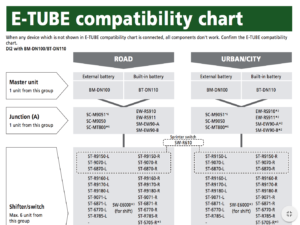
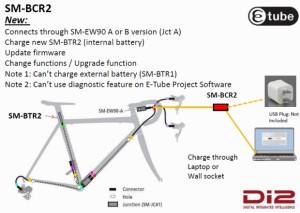
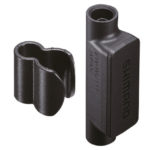
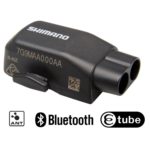
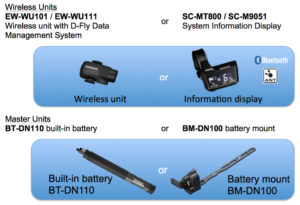
Do you know if the brake TT levers ST-R8060-R will work with the bar end shifters SW-R671 please.
Yes they will work together, but check the Shimano compatibility chart linked in the post above to verify.
Thank you for taking the time to reply.
Hi, I have St-R8050 Shifters, SM EW90-B Di2 Cockpit Junction Box 5-Port, Di2 SM-JC41 Internal Junction Box (4 ports), FD 8050 Front Derailleur, RD 6870 SS Rear Derailleur, Di2 External Battery Mount SM-BMR1-S, Di2 External Battery Mount SM-BMR1-S. and somehow the Shimano E-TUBE doesn’t recognize the battery. It is brand new battery and brand new Battery mount but system can’t recognize them, shows “Unit is not detected”. Any suggestion or recommendation? Thank you so much.
First, make sure everything has the latest version of firmware. Second, try connecting to just the battery and not everything else, with just 1 wire between the Junction A and the battery.
Hi Mr Bale, I have a problem trying to mix RD6870 and FD6770
I downloaded the E-tube_Proj_V_2_5_2.zip from Shimano. But I didn’t find any “C:\PROGRAMDATA\E-TUBE PROJECT\FW” related files.
What I found can be viewed below from my screen capture-
https://drive.google.com/file/d/13chYfW0062Jgjrr7xqBOoqq-oW2UJ15z/view?usp=sharing
Please help so I don’t have to purchase another 11SP front derailleur.
Thanks
The C:\ProgramData directory is a hidden directory. Here are directions how to view it (and also other possible locations of the similar folders) https://www.howtogeek.com/278562/what-is-the-programdata-folder-in-windows/
Hello, Thanks for your reply.
My current RD-6870 firmware is the newer 3.0 version, That I cant get it working with my old firmware SM-BTMR2 external battery, and ST-R785 shifter. That I have them downgraded to the old 2.5.2 version.
However, I cant find any RD-6870 related file in the FW folder. Could you help to share that older version? Or is it using other file name in the FW folder. Thx
Sorry, I’m not sure where to find that file. I only have the 2.5.2 software install package, not the individual firmware files.
Hello, I have the eTube 2.5.2 version installed. But the SM-BTR2 firmware version is SMBMR2.2.3.1.
My 6770 groupset is not working with my RD-6870 rear derailleur.
Could help to inform where can I find the SM-BTR2 BATTERY FIRMWARE AT V2.0.6 OR EARLIER?
Hey,
I’m new to the whole di2 concept and getting lost in a maze of serial numbers online. I’m looking at getting my first triathlon and because where I live is quite hilly I like to have a certain setup with the shifters that I’m not sure is possible. Ideally, I would like 6 shifter buttons, dual buttons on the tt bars to control both the front and rear mech, and then shifters on the breaks to control the rear mech (or the other way round). I know Syncro shift would probably work for what I want but I’d like the ability to be able to drop the front mech when going from fast flat to a steep incline.
So basically, I think my question is. Is it possible to have 6 different shifters on a tt bike and how what would the setup/junction boxes look like?
Thanks!
JR, this the standard triathlon/time trial setup. There is no limit to the number of shift buttons. You need a left/right SW-R671 Dura-Ace 2-Button Time Trial/Triathlon Bar End Shifters (or similar), left/right ST-6871 Ultegra Time Trial/Triathlon Dual Control Brake Levers/Shifters (or similar), and a 5-port SM-EW90-B 5-port Front “A” Junction (or similar.)
Hello, i have a bike with an older 6770 kit, that comes with an external battery.. It’s a second hand bike and didn’t come the charger. If i updated junction block a to the latest version that has the pc link and and charge port, would it be possible the use the latest charger to charge this battery? Or do i need to get the external battery charger. Thanks
Al, you have to use the external battery charger for the external battery. Only the internal battery can be charged via the the newer A junction charging port.
Hi Al, If your interested I have a spare charger for the external battery including a spare battery. Let me know if you are interested. I am living in the Netherlands.
Thanks for the offer Jos, I am in the states so shipping may be a bit much. I’m considering just biting the bullet and updating to the newer battery with the associated hardware.
Thanks for your reaction. One of the nice features of the new internal battery is Synchro-shifting. I am very pleased with it.
Succes upgrading your bike.
Hello Jos are you using a 6770 group with synchro shift? I searched and looks like i can’t use it for my group unless i do more upgrades 🙁 i may have to consider your offer
I am using the 6870 11 speed front and rear derailleur.
Regards
Jos
Hello Carlton…Thanks for your thorough and detailed summary. I have a Trek Domane SL road bike with a Shimano Di2 setup. I also have a Garmin Edge 810 computer. The Edge provides the option of displaying the Di2 Battery Life while I’m riding and I’d like to know that although it’s not critical. I’m also interested in the synchronized shifting, especially when I down shift from the big ring to the smaller ring, I’d like the rear derailleur to go up two gears, a fairly common option.
My questions are: What additional components are needed to enable the Di2 to communicate with my Edge? I believe I will need the DN110 internal battery and the EW-WU101 and EW-WU111 ANT and Bluetooth Wireless Broadcast Modules. Is this correct? What is the difference between the WU1010 and WU111? Do I need both? Any cables? Assuming I installed this, or had it installed, will I need to use the E-Tube Project software to program the shifting?
Thanks for your help.
Regards, -Burton
Burton, you are correct, you will need the DN110 internal battery and either the EW-WU101 or the EW-WU111 Bluetooth/Ant module. The two modules are identical in functionality; the only difference is the shape. You will most likely need on additional eTube wire to place either module inline. (You could install the SM-EWW01 ANT-only Wireless Broadcast Module if you just want Garmin gear selection display but need the new battery for SyncroShift.)
For SyncroShift, you’ll need a 6870 or newer derailleurs and the DN110 internal battery.
You’ll need the Windows eTube software to update the firmware after installing the new components, to enable/configure SyncroShift, and to enter gear ratios.
Thanks Carlton. Appreciate the update. Seems like a lot of time, money and effort. For now I’ll pass. Appreciate the education.
Hi Carlton, I have a 6870 series (Groupset) 11 speed Di2 setup that has the external SM-BTR1 battery and SM-EW67 A-E junction. I just upgraded my RD to the XT M8050 to allow a 11-34 cassette. I am told the firmware needs to be updated as evidenced by the new 8050 does not work while plugged in, and the FD now fails to function. I purchased a EW-WU111 to assist me in the firmware updates and other bluetooth functions. I just read the SM-EW67-A-E is not compatible with the EW-WU111. I prefer to not upgrade the battery to a BT DN110. Is there a better was to:
1. Achieve firmware updates?
2. Achieve Gear display and battery % on my 510 Garmin via another wireless D-fly system?
3. Can a SM-EW90 work with the SM-BTR1 battery?
Kevin
The DN-100 external battery holder has the memory function to work with the EW-WU111 Bluetooth.
Avoid doing firmware upgrades via Bluetooth. You run a very high risk of bricking the system and will then need the PCE unit to restore any Di2 functionality. Typically a decent bike shop will have one of these.
Just use the Bluetooth for setting changes, such as Synchro.
Kevin, you’ll need to update the firmware on everything using the Windows eTube software and PC adapter. The Bluetooth module won’t work until you update all other firmware first. As mentioned, you probably should do future firmware updates via Bluetooth due to higher possibility of failure.
Yes, the SM-EW90 will work with the SM-BTR1 but it won’t charge it.
You can achieve Garmin gear selection display via the Bluetooth/Ant+ modules or the Ant module alone. For Bluetooth phone settings support, you will need the DN110 internal battery (or the new external battery) and either the EW-WU101 or the EW-WU111 Bluetooth/Ant module. The two modules are identical in functionality; the only difference is the shape. You will most likely need on additional eTube wire to place either module inline. You could install the SM-EWW01 ANT-only Wireless Broadcast Module if you just want Garmin gear selection display – it does not have Bluetooth and does not require the newer battery.
Thank you Carlton for your advice. I am now looking at installing the SM-BTR2 with the SM-EW90-A to function with the EW-WU111. I will also pickup the SM-BCR2 charger with USB PC adapter to update the firmware to correct the current non-function/compatibility between the FD 6870 and the new XT M8050 RD. Hopefully this plan is sound.
Thank you again.
That sounds like a good plan!
Hi Carlton, I am currently using DA 9100 on a Tri bike. I have the 9160 switches on the extensions, and 9180 shifter/hyd brake levers. My question is, can I use the 9150 climbing switches to work in conjunction with the 9160s to shift the rear derailleur, and program the 9180s to shift the front derailleur? Anything I need beyond wires or junctions? Thank you in advance.
Bill, this setup should work fine as long as you add enough junctions and wires. You can configure all of the buttons using the Shimano eTube software.
Hi Carlton, Can a BMR1 charger and the mount for external batteries be used for the SM-BMR2? And does the SM-BM DN100 used the same charger as the BMR1 and hardware or another set of components? Thank you.
Kevin
Kevin, I believe the batteries themselves are interchangeable but you will not get features of the newer firmware. But everything must be updated to the latest firmware version. I have not done this myself, so hopefully someone else can confirm.
Thank you for the advice.
Hi! I have 6770 sti levers and front derailleur and a SM-EW67-A-E. They are not updated beyond 2.5.2 firmware.
I must buy a RD and battery mount( already have external battery). I’m thinking about getting a rd-6870, as my parts isn’t updated it should work with 11-speed.
Does it matter if I buy SM-BMR1 or SM-BMR2 (new from retailer), is there a risk that they will be updated beyond 2.5.2 and thereby making mixing 10 and 11 speed derailleurs impossible?
You will almost definitely need to update everything to the latest firmware to get the new parts to work. They will come with the latest firmware. My recommendation is that if you want to update to 11-speed, upgrade both derailleurs.
I have now got my system working with 11-speed using:
SM-EW67-A-E. ST-6770, FD-6770, RD-6870 and SM-BMR2
I have upgraded (and in some cases downgraded) firmware to e-tube 2.5.2 using SM-PCE02. No problems with this setup.
Warning! I first used a SM-BMR1 battery mount and only the front derailleur worked. It could not be updated using the SM-PCE02. E-tube could not find the SM-BMR1. I suspect that to update the SM-BMR1 you need the Sm-PCE1. I bought a SM-BMR2 and had no problem updating that using the SM-PCE02.
Hi, Martin, could you inform which firmware file did you used, on updating the RD6870? I cant locate a 6870 named dat file in the FW folder, in 2.5.2 firmware folder.
Please help. THX
I installed SW-R671 into my Di2 6870 road bike. It’s shifting okay but my etube does not recognize my SW-R671. What shall I do to make it recognize?
Have you applied the latest firmware versions to all components?
Re: steps #3 & 4 on adjusting rear derailleur trim-are you saying push the lever that normally moves the chain to a higher gear & use it to move the chain toward the 4th cog. Then after you hear it rub, hit the other lever 4 times. The 4 times -does it calibrate or realign and make the shifting all fixed? I am struggling, my shifting is off & when I fix one area on the back cogs, another area starts messing up. Thanks for any help.
I have a 9070 Dura Ace full groupset. My question is can I install or add wifi cable to make it wifi capable? Because I brought it to my local bikeshop and they said it is not possible due to compatibility issue of 9070 rear deraileur. But before I guve up, I still want your oppinion and knowledge on di2’s specifically on this issue.
Regards,
Carl
Carl, I assume you mean Bluetooth and not WiFi (there is no WiFi module.) If you have the newest battery, you can use the Bluetooth module. All of the details are in the article above and have been discussed recently in the comments.
Hi Carlton, I have a dura ace 7970 tt system which has developed a fault. The rear derailleur changes through all the gears on one press of a shifter button ( up or down). It would also seem it shifts more times than it should followed by a lot of clicking. Can these derailleurs be reset or am I looking at a new system.
Regards
Matt
It could be that there is an issue with your shifter button or wiring, but it’s more likely that the derailleur is the issue. A used replacement part off ebay would be the potential cheap solution. But a full upgrade may be the best bet.
Hi, my bike is equipped with Di2 9150 and the battery is constantly discharging. The bike shop I purchased the bike from have replaced two batteries and all the wires and the problem continues to persist. Currently the battery life is less than 6 hours after a full charge.
Note, the bike is still just over 12mths old and I known Shimano warrants these components for two years. The shop have been great support but the problem is beyond frustrating. I suspect it is the front derailleur..?
What are your thoughts?
It’s hard to say it’s the front derailleur for certain, but at this point, the bike shop should start swapping parts to make the problem go away. That is crazy low battery life. I’m assuming they have made sure everything has the latest firmware version. It should be possible to measure current draw on the batter with a multi-meter; there should be a drop in current draw when the offending component is disconnected. You will need to sacrifice a Di2 wire (cut one of the leads and place multi-meter in series) to measure the current draw from the system battery. https://youtu.be/7lwZkl0yBqA?t=94
I have one of these leads. I had a Fluke DMM connected in series with it, it did not read great, and it effected the calibration of the rear derailliuer. I then used a clamp on mA meter and this worked fine. I found my rear derailliuer was drawing 2.0mA . Changed the derailliuer and all ok since. You could always check the voltage drop twice a day for a few days, this will point you to the faulty item. Firstly disconnect the rd, then the fd. As your battery is dropping quickly, it should be fast to pin point the problem. Mine was not and it looked like a battery problem .
Hi, just some feedback I have tried the basics and disconnected the front and rear derailleur and the fault tends lead to the front unit. What I have also noticed the battery discharges quickly when the system is in semi or auto mode which again makes no sense..? As previously mentioned, the bike shop has replaced all the wiring and charging unit but the problem still persists. After a full charge, I have done just over 100kms and my battery power is on 70% and this is when the power discharges rapidly after each use.
Hi, hope you can give me some guidance here. When I charge my Di2 it lasts less than 4 rides (30/40 miles each) and 2 weeks. I charge following your recommendation until lights turns off. I noticed that when I “test” the battery it shows green and 3 seconds after it shows green and red together.
What do you recommend me doing? Something is not working well because I read it should last at least 1000 miles or so.
Thanks in advance!
Eduardo
Any recommendation to my question Carlton? Have you seen that before?
Eduardo, your battery might be bad. But it’s more like that one of your derailleurs is bad and is continuously pulling power. Trial-and-error is the only way to figure out which component it is. Read through the recent comments on this post for others who have experienced the same problem.
What about changing a older sm-btr1 to the btr2 so I can get synchronized shifting what’s the process? Tried looking online but really can’t find anything. I know firmware but will the battery just plug in with the same connector?
you need the DN-110 battery for synchronised shifting. BTR-1 and BTR-2 do not have the memory function to support synchro.
My bike has ultegra Di2 6770 system, may I ask can I replace the RD 6770 by Dura Ace RD 9070? Thank you.
No,both the front and rear derailleurs need to both be 11-speed (or both 10-speed). Upgrade both front and rear, or get a new rear to match the front.
Hi Mr Bale. Do you know if is possible I become a 7970 di2 10v road groupset to 11v speed only changing the rear derailleur to 11v (like a 6870 or 9070 for example)? thank you
Cesar, this conversion is not possible. 7970 components are not compatible with anything else. Full details are in the article above.
Dura-Ace 7970 10s is completely incompatible with any of the 11 speed E-TUBE system.
If you want an 11 speed setup you will need a completely new 11s group
Hi and thank for an extremely informative page!
I have a system with st6770, sm-bmr1, sm-ew67 and I’m changing from 10 to 11-speed derailleurs. To do this I have updated firmware using sm-pce02.
The update process work well for all parts but the sm-bmr1. E-tube can not find it and I get a message saying I need a sm-bcr1/sm-bcr2/sm-btr2 for the system to work.
Shifting works like normal when using the old 10-speed derailleurs.
Any Ideas how to get e-tube software to find and update the sm-bmr1?
Now I also tried clicking on the “cable icon” in e-tube and connect just the sm-bmr1 but with the same result. Hm….
It was my understanding that 10 and 11 speed won’t work together with the latest firmware and this needed rolling back, your 11 speed rear will undoubtedly have the latest firmware? I presume you’ve used the sm-bcr02 to plug into the sm-bmr1 via the etube cable?
The article also states that
“THE PROBLEM COMPONENT IS THE BATTERY (EXTERNAL BATTERY MOUNTS SM-BMR1 AND SM-BMR2, INTERNAL SEAT POST BATTERY SM-BTR2.) IF YOU KEEP BATTERY FIRMWARE AT V2.0.6 OR EARLIER, THE SYSTEM WILL CONTINUE TO FUNCTION PROPERLY. SHIMANO E-TUBE SOFTWARE V2.6.0 WILL UPDATE BATTERY FIRMWARE TO V3.0.5, AND WILL NOT ALLOW THE RD-6870 TO WORK WITH A FD-6770 SETUP.
IF THE BATTERY FIRMWARE IS UPDATED TO 3.0.5, IT CAN NOT BE REWRITTEN BACK TO THE OLDER VERSION.”
Thanks for your reply! I have changed both derailleurs to 6870 so it should work? Also even if I connect only the battery mount e-tube software can’t find it.
I have now read that the sm-bmr1 might only be able to update using sm-pce1 and not sm-pce02. https://bettershifting.com/learn-how-to-update-your-di2-component-firmware/
Could that be the problem?
I have now solved the problem. It seams that the sm-bmr1 cant be updated with the sm-pce02. I got a SM-BMR2 instead. Updated it and everything works ok.
Hi
I tried to run an update on 6670 groupset. During the uptate it failed and now e-tupe wont reconize the left lever. I have tried to connect in both ports in the lever on its own, and also via other components. But it do not appear 🙁 Is there a solution, or do I need to get a new left hand lever 🙁
Thanks in advanced
Sorry its a 6770-L lever and groupset of course
You should be able to re-flash the firmware to the shifter using a PCE1 adapter. That’s what I would try first.
Is there any documentation of the overall protocol used on the e-tube bus for the STEPS systems, specifically the D5000 gear? I assume it’s the same for the D6000 etc. I have seen comments on some forums that suggest it’s encrypted.
I’ve never seen it fully documented, but it’s a standard CAN protocol and it’s not encrypted. You can attach an oscilloscope to the harness and read the commands. The most common commands are right shifter upshift/downshift and left shifter upshift/downshift that are sent when activating the shifters.
I have put an oscilloscope on the wires. 30 years ago I was an oscilloscope ace, but clearly not now. There are only 2 wires, power & “ground”, the signal is modulated onto the power wire, and we were not able to see any distinguishable patterns with the different shifter commands. We saw movement. We were using a scope without any additional bus protocol software. Then Shimano came out with syncro-shift and I stopped investigating. And I never added syncro-shift anyway.
Once the lever is pressed the voltage rises by, I think 0.3 to 0.5 volts on the wire. This is not from the derailliuers because with both plugged out, the voltage still increased with the lever pressed. This test was done with 2015 year battery on a 6870 system.
Hi Carlton
first thank you for your site and info on DI2. it has been very helpful and informative.
i have a question:
have you ever dealt with an error message in etube saying there was an issue connecting to the PCE-02? And that if the problem persists it could be a faulty PCE-02?
i was trying to revert my firmware to mix and match RD-6870 and FD-6770. Halfway through the process (i believe when i was updating the battery to the “new version”) it gave me the fault, and now i can’t even connect
any thoughts?
thank you very much for your time
I’ve never heard of this before. I’d be surprised if there was a hardware failure during the update. It seems more likely that there is a PC software problem. I’d try uninstalling and reinstalling everything.
thank you! i’ll give it a try
Hi Carlton, so I figured out it was the battery mount, SM-BMR2, that is causing the “faulty PCE-02” message.
So, i ordered a new one, and now the PCE-02 wont even recognize the SM-BMR2. It goes through the process of trying to recognize the device, then just goes back to the home page of e tube. THis happens both when i connect to the whole system through the shifter or directly to the battery mount (with and without battery installed).
I read online thaat someone only was able to resolve this by finding someone with a PCE01 and having them update it as the PCE02 sometimes has issues. I dont think i have this option.
Would you happen to have any suggestions?
Again, thank you for your time
Dex
Hey Dex,
I think that is the case for the SM-BMR1 only, but I’m not 100% sure on that..
My suggestion would be to phone a couple of bike shops and ask them to check it with their SM-PCE1 – most of them should still have that.
Hi Carlton,
I’m running Ultegra Di2 6870 and I’m finding the rear shifting not smooth under load when it’s on my Tacx Neo Turbo trainer. I’m not getting hesitation or any clicking but it’s changing quite abruptly and interrupting my pedal stroke. There’s also quite a ping when it changes gear under load. I think all the limit screws are set OK – it’s shifting into all gears and no noise when it’s in a gear. I tried a spare cassette to rule out the cassette and same issue with both cassettes I tried. I’m at a bit of a loss with why it won’t shift smoothly when under load. Any suggestions please?
Thanks,
Andy
Hi, I had the same problem with my Tacx Neo and my Trek Madone with Shimano Di2 6870. It turned out that the cassette hub was placed too close to the flywheel of the /tacx. Through the Tacx website I ordered a spacer which I placed on the Tacx Neo. Instructions can be found on the Tacx website. Hopefully this will solve your problem.
Greetings
Jos
Thanks Jos.
Struggling to find what you refer to on Tacx website. Do you have a link?
Thanks
Andy
Here https://tacx.com/nl/spare-parts/neo-smart-nl/ you can buy the S2800.01 sparepart set. containing following parts.
T1402
Ouick release, rear wheel (1)
T2805.06
Spacer 5mm for discbrake (1)
T2805.11
Free hub body spacer 1mm (1)
T2805.12
Free hub body spacer 0.5mm (1)
T2805.16
Fill ring Shimano 10 speed (1)
When you dissaassemble the cassette you find a little black tube. Remove that tube and then place T2805.11 or T2805.12. Then place the black tube back and then your cassette. It’s a matter off trial and error. I hope this will solve your problem.
Regards
Jos
I have a 5 or 6 year old 11 speed road di2 setup, mostly Dura-Ace but the rear derailleur is the wider range Ultegra. In the past few months the system has started to forget the rear derailleur adjustment settings. Originally it seemed to happen only when charging the battery, but it has progressed to happening while riding at 30F. Is the adjustment memory in the derailleur or in the battery? My guess is rear derailleur because the front appears to be fine, but I seldom shift the front.
I would assume that the setting is stored in the rear derailleur itself, but I can’t say for certain. My guess is that your rear derailleur is starting to fail and that is causing the problem. I’m not sure if it’s a mechanical or electronic failure, but either way, trying a replacement derailleur is probably your best best.
This problem has been with one of the Di2 bikes in the family.On the big ring I cant shift onto the smallest sprocket. Can move onto the largest sprocket. On the biggest sprocket tube shows that the chain is on spokes 2 when in fact its on 1. Using custom shifting one tube it’s impossible to show the chain on the correct sprocket ie No2. This logically explains the inability to get the mech to move onto the number 11 sprocket. How can I make tube recognise the correct chain position?
This is not a software problem. This is a physical alignment problem. You probably need to adjust the limit screws on the rear derailleur. And then recalibrate the trim via eTube after getting the limit screws adjusted properly. Instructions for doing this are in the Shimano installation instructions. There is a link in the article above (or do a Google search.)
Yes software I suppose. I cured it by backing off both limit screws – the high limit screw was well baked out in fact. Then moved setting to manual and was then able to move the chain onto the smallest sprocket. . Still on manual onto largest sprocket, now into adjustment mode to adjust the rear mech to correct changing between sprockets. Seems ok now and E-TUBE shows the correct actual sprocket selected.
Hi There – a new question. I’m in the middle of converting an old bike (without internal cable routing) to Di2. Would you happen to know if an SMBTC1 (and BT DN110) can be used instead of BM DN100 (plus SM BTR1) plus SM JC40
There should be no issues with using the external battery mount with the BT DN110 Battery. (I would personally use that instated of the other external battery mount.)
Just by way of an update I have now assembled externally routed cables with the BTC1 and BT DN110 – it works perfectly and in my opinion results in a much neater and better integrated solution that the old style battery mounts
That’s good news!
About Short bottle cage battery mount, SM-BMR1 and SM-BMR2
Would you have any idea for a short length external battery mount, to be placed under the existing bottle cage closer to the BB?
Is there any rod or extension mount could be used to adapted to perform like a long length mount?
THX
Hi Carlton. I have 7970 Dura Ace Di2 on my trusty 2010 Felt Z2 which i love. The gears have recently gone on the blink and even after buying a new battery it still discharges quickly even when not riding. I read in a previous post that possibly either the FD or RD is continuously pulling power. Is there anything i can do if that is the case?
James, the first thing to check would be the wiring. Make sure that there are no shorts between any of the cables. But my guess is that it’s probably one of your derailleurs. Disconnect the front and see if there is still battery drain. Then do the same with the rear. Ebay.com is probably the best place to find replacement parts. If it’s in your budget, upgrading to one of the latest Di2 systems would probably be worth it.
I had two issues, both were battery drains. The first I thought it was the cold garage that was draining the battery, changed the 5volt charger and all ok since, that was four years ago. Then three years ago the same thing happened. Traced it to the rd drawing 2mA constantly. I had a rd and changed it. Things gmhave been perfect since……some day, I might just plug the cable into the old rd and see if the fault is still there.
Thanks Kevin. I was hoping that if i left my bike alone for a while it might miraculously repair itself! Sadly hasn’t.
I’m going to test whether i might have the same problem as you. I’m on my second rd after a crash. They’re not cheap!
Hi James, I had a cable that I cut and measured the voltage level. I also measured the current with a meter inline was not great and it put the rd out of calibration. I used a small clamp on DC ammeter and this was ok. But if you have none of these, time is another tool. See how long it takes to discharge with everything connected. Then disconnect the rd and see if the battery lasts beyond the time with everything connected. ..The faulty rd I had, still changed gears, but was draining.
I have successfully combined 2 broken rear derailleurs into one working rear derailleur. Maybe you can fix the crash-damaged derailleur with parts from the one with broken electronics. Or vice versa.
Hi James I was looking for a screwdriver to open the locking screws they use, but have not found one yet, that would be the next move. That would allow one to swap the motor out.
Thank you Carlton. I did buy a diagnostic tool and know that both derailleurs work but i didn’t wait to see if one was draining the battery. i also bought a new battery and Junction A as the latter didn’t seem to be signalling the battery level at all. I also checked out upgrading to a later system but i believe that as the bike is old i am limited to which series will fit.
James, you should be able to upgrade to a newer Di2 version, but you probably will need a new rear wheel and sprockets (to go from 10-speed to 11- or 12-speed.) You should not have to upgrade your front rings or crank if you to an 11-speed system, though I think the 12-speed system has a narrower chain that may require replacing the front rings. All new cables will also need to be run. It’s a major undertaking and not for the faint of heart. Identifying and replacing just the component that has failed is your best bet.
That job is well above my pay grade Christian. I have taken the bike into a few good bike shops but to be honest they’re not really interested in seeing if it can be fixed.
I will test the RDs as you suggested first i think but many thanks for the advice. I really appreciate it.
so i fully charged the battery, unplugged the rear derailleur and waited to see if the battery discharged. It did in two days! Thought that was my issue until i recharged the battery, plugged in the rear and unplugged the front. Rear doesn’t work at all.
Think i need new gears!!
Hi Carlton. I’m building a new bike with DA9150. my RD-R9150 and FD-R9150 have been shipped and are somewhere in the world right now. i thought i could use an RD-9070 and a FD-9070 temporarily. I’ve upgraded the firmware to the latest but there’s no response from either FD or RD.
are there compatibility issues?
thanks
Aman
I don’t have direct experience with 9150. I’m not aware of any protocol changes that would make your setup incompatible. It theoretically should work. Perhaps the issue is the computability updates are not out yet for newer components?
Great site! I run DI2 with XTR RD-M9050 rear, FD-M9070 front, and a SC-M9051 display, I am running full syncro shifting. Not sure if it is a programming issue or what, but it is programmed to move up one gear in back when dropping down into the small front ring. About 10 percent of the time it only up-shifts the rear no downshift up front, it may or may not downshift the front after maybe 10 seconds. I have not been able to duplicate this on a bike stand but it is devastating on a ride. Battery is fully charged any ideas?
My guess is that it’s a mechanical problem and not electronic. Try readjusting the set screws and front derailleur positioning.
Hi, I have an early di2 set up Ultegra 6770 with SM-EW67-A-E Ultegra 3-Cable Junction, I find some people can not resist playing with the paddles, as there is no off switch I can come back from work and find things not right so to speak, how can I add a hidden off button so nothing works at all till I switch it all back on? as for where IO hide it I have lots of options I just want to know how to do it without causing damage to the system.
Just disconnect a wire to the battery. Just remember to reconect before you ride off. Easier obviously with external battery vs innternal
I agree that unplugging one of the cables is the easy solution. But it is a bit difficult to plug and unplug the cables – they are designed to not come out of the connector accidentally (and are difficult to reinstall.) Shimano has an Etube connector tool that makes this much easier.
If you want to install a switch, it’s simple to wire. Di2 is a 2-wire system. Splice into the wire going from the front junction to the rear junction, or from the rear junction to the battery. When the switch is “open/off”, there will be circuit will be open, and communications and power will not work. When the switch is “closed/on” it will function normally. I would put the switch in the ground wire, but it doesn’t really matter which of the two you pick. Cutting the wire and splicing/waterproofing the will be the most difficult part. I recommend adding an additional cable (with inline switch) and a SM-JC41 Junction to your existing install instead of cutting/splicing an existing already-installed wire.
I was hoping to avoid splicing wires, so untidy, I will take a look at the problem now I know I can disrupt power without damaging the system, I will probably just remove the battery for now but putting a switch into the earth line looks promising, if someone has a destroyed di2 brake lever I can buy cheap to rob of parts to make a plug in diversion I would appreciate it. G J Power
– email is powerclocks at hotmail (dot com).
I am looking into your idea with the SM-JC41 plug, I will have a chat with my local mechanic and see what he has in his box of tricks, one other question, I want to add wireless EW-WU111, I was going to put it before the bottom junction box inside the frame before I get my local mechanic to tune the system so he could set it up properly, he has said don’t do it, it could cause unexpected problems with the shifters, am I going to the wrong mechanic?
That’s how I’ve had my wireless module mounted for years without issue.
Each additional connector you add to the system slightly increases the risk of some type failure, but not significantly. I wouldn’t worry about mounting it there.
My legacy Dura-Ace 7970 groupset came with a BTR1 and BMR1. I’ve just purchased an FD9070, RD6870, EW67A-E, and a JC-40 to upgrade to an 11 speed setup. Will I need to replace the BMR1? Thinking that the E2 cables won’t be accommodated because the BMR1 currently uses the 5-port cables. Thanks in advance for your reply.
Nothing is compatible between the 2 systems. You’ll need to purchase all new cables.
Thank you for a great article. My TT bike has a 10 speed 7970, which is not working well after crash. Unfortunately, it is not possible to get a new derailleur. On ebay I found 10speed 6770, which I am considering to buy, but based on your article 7970 cannot be replaced by any other derialleur. Is that right? What would you recommend me to do to get my bike functioning? Thank you very much for advise! Tomas
Tomas, you are correct, you cannot use 6770 components with 7970. The cheapest solution is to create a search notification on eBay and wait for the part you need to be listed. If you have the budget, replacing everything with a more modern system is a worthwhile investment. You may need a different rear wheel/hub to go to 11-speed or 12-speed. That’s the route I’d take.
Hi, I have been here asking questions previously and have a new inquiry, I have had my Ultegra Di2 10sp set up for me at the local bike store but there was a problem and it will not go to the large cluster, I am told the derailleur is badly worn and the slack in the derailleur itself is the problem, I can accept that as it does feel loose, are these repairable, I thought I would ask before I started down the track of removal and attempting repair. perhaps I should be looking for a better one or a damaged one for parts?
Do you know if the internal junction box can be replaced by a diy harness cable?
Yes, it’s just 2 wires inside each cable. Connect them in parallel and it will work the same. There are no electronics in the internal junctions.
https://www.youtube.com/watch?v=3n08irfCdM4
any clues how to fix this problem thanks
If it was working properly and now it’s stopped working, then it’s probably a failed rear derailleur. You need to replace the derailleur.
I had a road bike with Di2 set up and working perfectly. I decided to switch to a different bike, bought a new frame and paid a mechanic to move everything from the old frame to the new frame. Now the wireless connection to my Garmin is not working. The mechanic left for vacation right after I picked up my bike and won’t be back for a week. I tried pairing the Garmin with the wireless unit based on the existing sensor stored in my Garmin multiple times, then removed it from the Garmin screen and tried discovering it, but no success. The Garmin is still working with the wireless Di2 on a different bike, so it’s not the head unit. I plugged the problem bike into my Windows laptop and the E-Tube software lists the charging port/junction box, the battery, both derailleurs, and both shifters on the left side of the screen that has the inventory. It does not list the wireless unit. In the diagram, it shows the above components and has a row in the table for “wireless” which (strangely) says “1 units from this group” but no model number, the right column of the table is blank (unlike the other rows which have the model number for each device). Does that indicate the wireless unit is plugged in and not recognized? Or is it missing or not plugged in all the way? If I could diagnose and resolve this myself, I’d like to, I don’t really want to wait for him to get back. Thank you!
It’s hard to tell what’s going on here, but it sounds like maybe the Ant+ unit isn’t plugged in. You definitely need to check to make sure it’s there and connected properly. There’s also the possibility that there was a failed firmware update by the mechanic? This is just a guess, but something to consider.
Hi Carlton. Great site. I have an Ultegra DI2 setup on my Trek Domane. FD-R8050. RD-R8050. BT-DN110-A. SM-EW90-A. EW-WU111 BT Module. When I connect to the eTube mobile app I can NOT select my 11-34 cassette (only 11-28 or 11-30) . my Trek shop did upgrades to firmware last week and the mobile app says all components have “latest” firmware. Is there a way to add the 11-34 cassette? I like the Gear display it creates on my Garmin 1030 but I would like it to be accurate. Y
Thanks again for great site…
I think the issue you are having is because you have the SS short cage length rear derailleur. Shimano requires the GS medium cage length version for official compatibility with an 11-34T cassette. In my experience, the short cage derailleur generally will work with 11-34 cassettes, but it is not something officially supported by Shimano. You’ll need to get a RD-R8050 GS (medium cage length) derailleur for that 11-34T gearing option to become available in the eTube app.
Cage Length [SS] short, [GS] medium
Capacity [SS] 33T, [GS] 37T
Cassette Range [SS] 11-30T, [GS] 11-34T
Does the rear derailleur have different programs for the different cassettes? I had always assumed not, but it is a possible tuning parameter that Shimano could have chosen to implement.
The rear derailleur isn’t calibrated specifically to the gear diameters/ratios. It moves a fixed distance side to side, regardless of sprocket sizes. The only time the rear gearing is a factor is SyncroShift coordination between the front and rear derailleur. For SyncroShift to work properly, the front derailleur will move down to the smaller sprocket and the rear will move up a few positions to a larger sprocket. The resulting gear ratio should be one step “easier” than the previous gearing combination. To calculate this properly, the Di2 controller needs to know your front/rear gear ratios and when/how many gears to skip during front/rear combo SyncroShift to give the next appropriate ratio.
For SyncroShift to work properly on your bike, you either need to use a supported rear sprocket size, switch to a GS long-cage derailleur, or just deal with SyncroShift not working perfectly (or disable it completely.)
Does eTube show the option of a larger than 28 rear cassette if you have what Shimano thinks is a compatible rear derailleur? I run a rear 32 with my DuraAce short cage setup and it works with synchroshift but of course only shows the 28 on eTube. It shifts well but I guess the combination after synchroshift isn’t optimal. Nevertheless it seems OK. Also, my frame builder said the DuraAce short cage rear derailleur working well with a 32 depends on the dropout. Mine works great with the 32.
eTube will show a different (approved) cassette range for the short cage vs. the medium cage derailleurs. eTube won’t let you manually specify anything other than their approved sprocket sizes…because that’s the Shimano way.
Can one use a newer Ultegra 8050 GS rear derailleur in an otherwise Dura Ace 9070 setup to get that extra cassette capacity? Are the shifters compatible between these generations and will eTube be OK with it?
Hi Carlton, Thank you for the years of advice and information. My question today is: Can I disconnect my front derailleur from the DI2 system without causing havoc? I plan on racing an IM (flat course), using only the 39t chainring (39-53t), and I figured why have the extra hardware, if not needed. Thank you.
Yes, you can disconnect and remove the front derailleur without issue and the rear will still work. These 1x setups are becoming more popular, especially with wide ratio 12-sprocket rears becoming common.
Hi Carlton,
Are you doing the 12 speed DI2 now as well.
No, I never actually upgraded to 12-speed. I figured I’d upgrade when I got a new bike, but I’m still happy with my old one. It’s faster than I am.
Hi Carlton,
Can I use an Ultegra Di2 8050-GS mid cage rear derailleur with my Di2 Dura Ace 9070 setup to get extra cassette capacity?
thank you in advance
You have to upgrade both the front derailer and the rear derailer if you want to change to a different cassette capacity (10 to 11, 11 to 12, etc.)
I think the OP just meant a wider range cassette with the same gear count.
Yes I am only talking about a changing cassetteto a wider gear capacity (max 28 to max 34) but still keep 11 speed system.
Thanks for the clarification. I should have looked closer at the part numbers. Yes, you can change from an 11-speed short-cage to an 11-speed GS long cage rear derailleur without changing anything else. This will give you compatibility with a 34T cassette (the short cage only supports up to 30T.) You may need to update everything to the latest firmware to get it to work.
FYI: I have been using a 11-40 Shimano MTB cassette with the Ultegra Di2 8050-GS mid cage rear derailleur and 50/34 on the front. Two extra links in the chain. I am using synchronized shifting just to make sure I will not go big/big.
This is good information. In my experience, all the Shimano rear derailleurs work with larger cassettes than what Shimano officially supports. Shimano just wants to rule out any possibility of an issue, so their recommendations are very conservative.
I have been using 46-26 chainrings on my Di2 setup for 5 or 6 years. Shifting is acceptable but not great.
And if I knew how to reply to Bob Goodman, the single button TT 11 speed shifters are apparently software upgradeable to 12 speed. Unfortunately the R671 2 button tt shifter is not listed and that is how my main EPS conversion shifters are constructed. I do not own any single button shifters, but it appears that the R671, the corresponding tt brake lever shifters, and the standard road bike 11 speed shifters all use the same circuit board, with some manufacturing option to tell the system what it is. For example, the system knows that I have 3 R671 shifters on my bike, the 2 boards in the EPS shifters and the one actual R671 on the aero bar.
I read somewhere that the 12 speed di2 cable brake shifters are reworked 11 speed shifters, and they are wired into the battery instead of being the new wireless. I have not bought those either (or any other Di2 12 speed stuff) so I do not know.
Time to get a job with Shimano on the Di2 software team to make my own bootleg 12 speed setups.
Guys,
I have been running an 11-36t cassette for ages now and it works perfectly.
Some hangers MAY need to use an additional extender like the Wolftooth but many don’t.
That larger ring is fantastic on those big hills.
Are the 11 speed shifters compatible with 12 speed? The compatibility charts imply that they are not. It would be nice if they were, because then my EPS shifters converted to di2 would still work.
As far as I know, all shifters work across all 10-speed/11-speed wired setups. They all send the same simple “gear up” or “gear down” commands. Wireless (semi-wireless…no wire between shifters and derailleurs) is a different story.
You can’t use older 11 speed shimano di2 shifters with the newer shimano 12 speed system. They are quite different, including the semi wireless capability of the shimano 12 speed di2 system components
Only the R9150/R8050 TT/tri shifters are compatible, and the SW-R9150 satellite shifter.
All other 11-speed shifters / switches will not work, unfortunately.
Hi Carlton.
I have two bikes setup with 6770 10 Speed. I have lots of spares, RD’s, FD’s, junctions, shifter etc. I have only ever used the external battery.
One of my bikes, the RD and FD will not respond. Tried swapping out the FD, RD, junction box and Shifters.
It is possible I swapped batteries between the two bikes at some stage. Have also tried dffferent battery holders and different batteries.
The junction box shows a charge and a change signal coming from the shifters.
Where is the firmware for the system? Is it in the battery or the battery holder?
Thanks for continuing this great site – esp for people like me who like to keep old gear working!
PW
5 minutes after posting this I realised what I had done wrong – all of the cabling is internal, and I use and external junction box mounted under the bottom bracket. I had removed the wires from the junction box to replace a rubber grommet in the down tube where the wires poke through. When replacing them, I had placed both ends of the battery wire in to the junction box and connected the battery directly to the SM-EW67-A-E Ultegra 3-Cable Junction. So obviously nothing was happening!
I’m glad you got it figured out!
As it turns out I also had a faulty battery holder (SM-BMR1) – swapped out for a different one and it all works fine.
Do these go ‘bad’ for a reason? Are they sometimes incompatible with individual batteries? Do they hold any ‘firmware’. or is that all in the battery itself?
I hear of these external battery mounts failing fairly frequently. I’m not sure why, but there is some design deficiency.